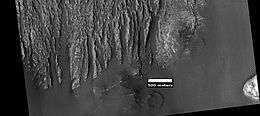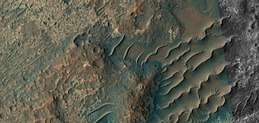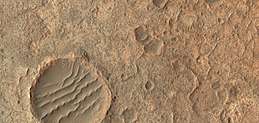Transverse aeolian ridges
Transverse aeolian ridges (TARs) are a type of sand ridge on Mars and are one of the most common landforms on Mars.[1] They are mid-way in height between dunes and ripples; they are not well understood. One possible mechanism for their formation is that larger grains like pebbles are rolled on top of smaller ripples; then, finer dust settles into the cracks, making the TAR larger than typical ripples.[2]
TARs are often seen in low places like valley floors. Currently, they are not moving. TARs are most common near the equator.[3][4]
In a study reported in the planetary journal Icarus, TARs seem to be similar to landforms in the Lut desert of Iran. The measurements of length, width, height, and wavelength of the landforms in the Lut Desert and TARs on Mars overlap. Lut bedforms are classified as mega-ripples, hence Martian TARs may also be mega-ripples.[5]
The term "transverse aeolian ridge", or "TAR" was first used by M. Bourke et al. in 2003.[6]
Transverse aeolian ridges are thought to be very ancient and currently inactive.[7]
Images of Transverse aeolian ridges (TARs)
 Yardangs, as seen by HiRISE under HiWish program. Location is Arsinoes Chaos. The next image shows part of this enlarged so that TAR's can be seen.
Yardangs, as seen by HiRISE under HiWish program. Location is Arsinoes Chaos. The next image shows part of this enlarged so that TAR's can be seen. Close-up of yardangs, as seen by HiRISE under HiWish program. Arrows point to sand ridges that are called "transverse aeolian ridges" (TAR's).
Close-up of yardangs, as seen by HiRISE under HiWish program. Arrows point to sand ridges that are called "transverse aeolian ridges" (TAR's). Layers in depression in crater, as seen by HiRISE under HiWish program A special type of sand ripple called Transverse aeolian ridges, TAR's are visible and labeled. Location is Hellas Planitia in Noachis quadrangle.
Layers in depression in crater, as seen by HiRISE under HiWish program A special type of sand ripple called Transverse aeolian ridges, TAR's are visible and labeled. Location is Hellas Planitia in Noachis quadrangle.
 Close, color view of unusual transverse aeolian ridges, TAR's, as seen by HiRISE under HiWish program These features may have had variable local winds to make the wavy tops.
Close, color view of unusual transverse aeolian ridges, TAR's, as seen by HiRISE under HiWish program These features may have had variable local winds to make the wavy tops. Close view of TAR's with waves, as seen by HiRISE under HiWish program
Close view of TAR's with waves, as seen by HiRISE under HiWish program Close, color view of TAR's in a channel,as seen by HiRISE under HiWish program
Close, color view of TAR's in a channel,as seen by HiRISE under HiWish program
References
- Berman, Daniel C.; Balme, Matthew R. (2012). "Investigations of transverse aeolian ridges on Mars" (PDF) (conference paper). Lunar and Planetary Science Conference. Cite journal requires
|journal=(help) - http://www.uahirise.org/ESP_042625_1655
- Runyon, Kirby (4 February 2015). "Yardangs in Arsinoes Chaos". HiRISE. The University of Arizona.
- Berman, Daniel C.; Balme, Matthew R.; Rafkin, Scot C.R.; Zimbelman, James R. "Transverse Aeolian Ridges (TARs) on Mars II: Distributions, orientations and ages". Icarus. 213 (1): 116–130. doi:10.1016/j.icarus.2011.02.014.
- Hugenholts, C., T. Barchyn. 2017. A terrestrial analog for transverse aeolian ridges (TARs): Environment, morphometry, and recent dynamics. Icarus: 289, 239-253.
- Bourke, M. C.; Wilson, S. A.; Zimbelman, J. R. (2003). "The variability of transverse aeolian ridges in troughs on Mars" (PDF) (conference paper). Lunar and Planetary Science Conference. Cite journal requires
|journal=(help) - Berman, D., et al. 2018. High-resolution investigations of Transverse Aeolian Ridges on Mars: Icarus: 312, 247-266.